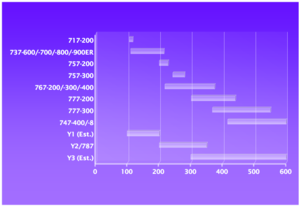Boeing: Difference between revisions
imported>Daniel Gonikman No edit summary |
imported>Daniel Gonikman No edit summary |
||
| Line 5: | Line 5: | ||
| org_name_short = Boeing | | org_name_short = Boeing | ||
| org_parent = | | org_parent = | ||
| org_logo = [[Image:Boeing-Logo.svg. | | org_logo = [[Image:Boeing-Logo.svg.png]] | ||
| org_homepage = http://www.boeing.com/ | | org_homepage = http://www.boeing.com/ | ||
| org_form = Corporation | | org_form = Corporation | ||
Revision as of 18:32, 17 October 2007
| Headquarters | 100 North Riverside Chicago , IL 60606 United States |
|---|
Legally known as Boeing Company, Boeing is an aircraft and spacecraft development company in the Aerospace industry. The company, together with its subsidiaries, designs, develops, manufactures, sells, and supports: commercial jetliners, military aircraft, satellites, missile defense, human space flight and space launch systems.
Company Heritage
Boeing was founded by William E. Boeing. Boeing was incorporated on July 15, 1916, as the "Pacific Aero Products Co.", in Seattle, Washington. The company changed its name to "Boeing Airplane Company" on May 9, 1917. [1]
Background & Birth
In 1903, two events launched the history of modern aviation. The Wright brothers made their first flight at Kitty Hawk, N.C., and William Boeing left Yale engineering college for the West Coast. Boeing moved to Seattle, Wash., in 1908 and, two years later, went to Los Angeles, Calif., for the first American air meet. Boeing tried to get a ride in one of the airplanes, but not one of the dozen aviators participating in the event would oblige. Boeing came back to Seattle disappointed, but determined to learn more about this new science of aviation. Boeing's air travel was mostly theoretical, explored during conversations at Seattle's University Club with George Conrad Westervelt, a Navy engineer who had taken several aeronautics courses from the Massachusetts Institute of Technology.
The two checked out biplane construction and were passengers on an early Curtiss Aeroplane and Motor Co.-designed biplane that required the pilot and passenger to sit on the wing. Westervelt later wrote that he "could never find any definite answer as to why it held together." Both were convinced they could build a biplane better than any on the market.
In the autumn of 1915, Boeing returned to California to take flying lessons from another aviation pioneer, Glenn Martin. Before leaving, he asked Westervelt to start designing a new, more practical airplane. Construction of the twin-float seaplane began in Boeing's boathouse, and they named it the B & W, after their initials. [2]
Early Years
After Charles A. Lindbergh made the first solo nonstop trans-Atlantic flight from New York to Paris in a Ryan monoplane in 1927, there was a tremendous surge of interest in aviation.
William Boeing developed a close business relationship with Fred Rentschler, president of Pratt & Whitney, manufacturer of the air-cooled engine that made the Model 40A a success as a mail and passenger transport. In 1929, Rentschler and Boeing set up a new holding company called the United Aircraft and Transport Corp. (UATC). The Boeing Airplane and Transport Corp. became UATC on Feb. 1, 1929, with Boeing as chairman and Phil Johnson as president. [3]
Company Operating Segments
Commercial Airplanes (CA)
Precision Engagement and Mobility Systems (PE&MS)
Network and Space Systems (N&SS)
Support Systems (SS)
Boeing Capital Corporation (BCC)
Historical Events
Joint Ventures and Partnerships
Boeing has a partnership with Lockheed Martin Corporation.
Future Plans
Yellowstone Project
- Y1-Intended to replace the 100-200 passenger aircraft (B717, B737, B757) [4] [5]
- Y2-To Replace the 200-300 passenger aircraft (B757, B767). Was originally developed as the Sonic Cruiser, became the 7e7 which became the B787.
- Y3-Intended to replace 300+ passenger aircraft (B777, B747)[6]
Links
References & Citations
- ↑ http://www.boeing.com/history/narrative/n001intro.html
- ↑ http://www.boeing.com/history/narrative/n002boe.html
- ↑ http://www.boeing.com/history/narrative/n010boe.html
- ↑ http://www.flightglobal.com/articles/2005/06/07/198872/not-if.-but-when.html
- ↑ http://seattletimes.nwsource.com/html/businesstechnology/2002838129_boeing02.html
- ↑ http://www.richardaboulafia.com/shownote.asp?id=59
See Also
External Links & Related Organizations
- Boeing Company Home Page
- New Airplane Official Site of Boeing's new aircraft
- Randy's Journal Blog of the BCA Vice president-marketing Randy Tinseth
